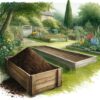One of my favorite things is to each a warm ripe tomato off the vine during summer, and its amazing how popular growing your own vegetables has become. Planting a potager or kitchen garden is a great way to get in touch with nature while also growing fresh fruits and vegetables. Not only will you be able to enjoy the fruits of your labor, but you’ll also be able to save money on groceries. Plus, you’ll be able to get outside and get some exercise in the process. Here is a quick summary of how to plant one.
When planting a potager or kitchen garden, the first step is to decide what type of garden you want. Do you want to grow herbs, vegetables, fruits, or a combination of all three? Once you’ve decided on what type of garden you want, it’s time to think about where you want to plant it. A sunny spot in your yard will provide the best environment for your plants.
Next, you’ll need to prepare the soil for your garden. Start by taking a soil sample to your local nursery or home improvement store to get a soil test. This will tell you what kind of soil you have and what type of amendments you need to make to ensure optimal growth. Once you have the soil test results, you can amend the soil as needed and then till the soil to break up any clumps.
When it comes to planting, it’s important to consider spacing and companion planting. Having the correct spacing will ensure that your plants get the adequate amount of sunlight, water, and nutrients. Additionally, companion planting can help to attract beneficial insects and deter pests.
Once you’ve planted your garden, it’s important to water it regularly and keep an eye on the soil’s moisture levels. If the soil gets too dry, the plants may suffer. Additionally, it’s important to keep an eye out for pests and diseases. If you spot any, it’s important to treat them quickly before they spread.
Finally, maintaining your potager or kitchen garden is an important part of the process. Regularly check your plants for signs of pests and diseases and prune them as needed. Additionally, make sure to fertilize your plants every few weeks to ensure they get all the nutrients they need to stay healthy.
With a bit of planning and work, you’ll be able to grow fresh produce that’s good for you and your wallet.










